Need for Speed: Hot Pursuit - Hands-on in London
It's hardly surprising EA gave Criterion a crack at the Need for Speed series; Burnout Paradise's considerable quality is testament to the fact that the UK studio knows how to make an open-world racing game.
The stakes with this series reboot, though, are high. With Need for Speed, by EA's own admission, having languished in recent years, that Criterion should make the property its own was essential. Has the studio succeeded? We played the game in London this week to find out.
[All text by Joe Anderson]
Irrefutably, Need for Speed: Hot Pursuit is like no other game in the series before it. There’s no story. There’s no dialogue. Instead, we're treated a wholly social experience.
The first thing you'll notice when loading up the game is Autolog. This is the game's lifeline, whether you're playing in career mode or the expansive online world.
Criterion describes Autolog as a suite of connected features which put friends at the centre of the game.
Social features are certainly the order of the day in Need for Speed: Hot Pursuit. One of the stand-outs is called The Wall, which allows you to type messages to people on your friend’s lists, share pictures and check out what your friends have been up to in-game.
Autolog has the ability to track everything that happens; if you post a new high score or time, the game will instantly update Autolog to show friends your new stat and allowing them to have a go at stealing your new-found glory.
Autolog will also give you recommendations based on your friends. It shows who's online and ready for a quick game; highlight your friend’s recent achievements; different games they've been playing; how many attempts they had; and even what cars they used.
Criterion said it felt competing against friends is much more important than playing with strangers, which is certainly evident from our time with the game.
Hot cop
Hot Pursuit is based in an area called Seacrest County, which consists of 100 miles of open road and 40 miles of shortcuts. We were told the roads have all been built with top speeds of 150-200 MPH in mind.
Criterion’s previously said one of its aims with Hot Pursuit is to reward players straight away; this is achieved through the new Bounty System, which is basically in-game experience. Whether you're playing offline or online, the bounty will carry over. If you attain a certain amount of bounty, you will gain in rank or reputation, depending on whether you choose to be a cop or a criminal. When you earn bounty you earn rewards, so generally once you finish a race you are awarded with a new car. In fact, in every race we played during the hands-on we were rewarded with a new ride.
Races are as frantic as you'd expect. During this week's session we managed to play in a Time Trial, a standard race, and in the excellent Pursuit mode. Pursuit was definitely the most fun of the three, with eight players teaming up in two groups of four. One group played the criminals and the other the cops. The main aim here, if you are playing as the criminals, is to get at least one car to the finish line, while the aim for the cops is to stop every car.
Not only is the action fast and frantic, but weapons also come into play. The criminal's weapons consist of a system jam, tire spikes, boost, and an EMP. The cops can call on road blocks, helicopters, EMP and tyre spikes. When you deploy one of your weapons, you will not be able to use any others until it’s replenished. The weapons do have limited use, so you need to make use of them wisely.
Catching up on opponents is never really an issue due to nitrous boosting. Nitrous is earned by near misses, driving on the wrong side of the road and generally being a daredevil with your extremely expensive car. Once you hit the boost button you better hold damn tight to the steering wheel: the game's fast enough as it is.
"Drunk on ice"
All of these fancy features and weapons would be pointless if the cars handled like a drunk on ice, which is definitely not the case in Hot Pursuit. All the cars we tried had a real sense of speed, and looked, felt and drove perfectly - especially when you are heading down a long, open road.
With speed, though, comes damage. You're going to crash. Unlike games where the developer doesn't want you to wreck luxury vehicles, Hot Pursuit demands it. Every time you have a smash, you are greeted with Criterion's now-legendary slow motion routine. Watching cars more expensive than your house fall to pieces in a split-second gives a satisfying feeling that's hard to put your finger on, but its works, and it’s beautiful.
Criterion Games has taken social features, speed and carnage and crammed it into one satisfying package. This may be Need for Speed, but it's Criterion's Need for Speed: November 11 can't come soon enough.









